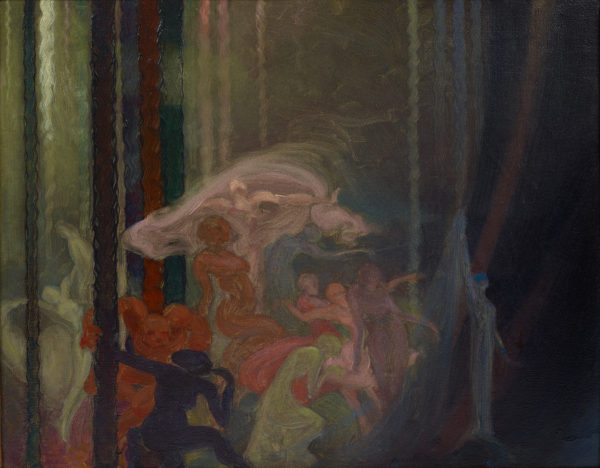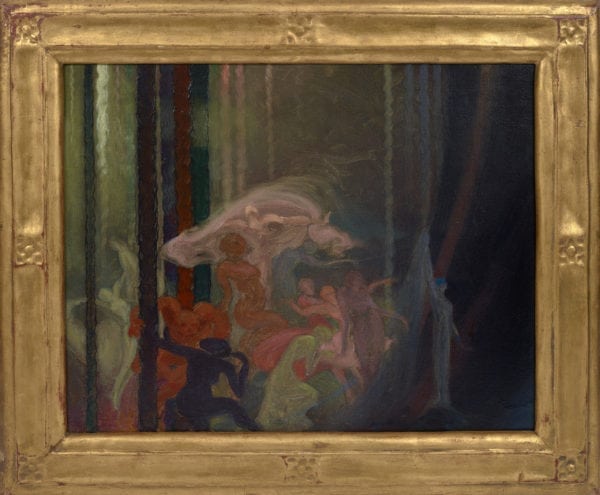French Music, ca. 1917
Agnes PeltonOil on canvas
14 1⁄8 × 17 5⁄8 inches
Original frame by Robert Laurent (signed on verso)
Provenance
Private collection, San Francisco
According to Agnes Pelton’s notes, published by Michael Zakian, French Music, was inspired by a symphony. Music had been a seminal influence throughout Pelton’s life. Her mother, Florence T. Pelton, was an amateur pianist and artist who encouraged Agnes to study art and music, during her childhood in Europe. Later, after Agnes’s father died prematurely, Florence opened a music school in Brooklyn. Agnes continued to study there and acted as her mother’s assistant.
At the time French Music was painted, Pelton was exploring representations of music and the points of confluence between sound and image. She was not alone in her exploration – artists ranging from James McNeil Whistler to Wassily Kandinsky had been similarly engaged. While some artists searched for the psychological equivalent between a certain note and color, Pelton was primarily interested in revealing and representing the parallels between the patterns found in musical compositions and the forces that create form and meaning in the world.
French Music is an unusual and mysterious picture. A group of figures, each painted in an unusual palette of greens, reds, purples and pinks, seem to be dancing vigorously or performing some kind of rite or ceremony. Draperies swirl around the central figures and the figure on the left. In a vision of physical release, the light pink figure throws her head back, revealing her stretched neck, and spreads her arms wide as her veils envelop her body and billow behind her. A few quick brushstrokes above her head imply the reverberations of sound. So too, are the vibrating vertical lines, which represent music.
The scene could also be read as a drama transpiring on a stage, which the viewer observes from the sidelines. The musical lines could represent ropes in the wings as the blue figure on the right pulls back the curtain. Theatrical and enigmatic above all, the sensuality and rhythmic pulses across the canvas are reminiscent of the work of the Symbolist, American painter Arthur B. Davies, who was an important influence on Pelton’s style, choice of subject, and romantic inclinations.
Note: French Music is in a frame made by Robert Laurent, an important modernist American sculptor and one of the leaders of the direct-carving movement. Pelton and Laurent knew each other from summers they spent together in Ogunquit, Maine at the art school created by their mutual mentor, Hamilton Easter Field (1911-1914). Laurent signed the frame on the back. As with other examples, Pelton chose to use a frame from her friend for French Music.
Exhibited
- Palm Springs, California, Palm Springs Desert Museum, Agnes Pelton: Poet of Nature, February 28, 1995 – October 6, 1996, no. 7, illus. Traveled to: Montclair, New Jersey, The Montclair Art Museum, July 8 – October 15, 1995; Southampton, New York, The Parrish Art Museum, December 3, 1995 – January 14, 1996; Logan, Utah, Nora Eccles Harrison Museum of Art, February 3 – April 6, 1996; Malibu, California, Frederick R. Weisman Museum of Art, May 4 – July 7, 1996; Oakland, California, The Oakland Museum, August 3 – October 6, 1996
Literature
- Michael Zakian, Agnes Pelton: Poet of Nature, exh. cat., Palm Springs Desert Museum, Palm Springs, California, 1995, pp. 30, repr. (color), 31, 50, 125.


